Mechanical Properties of Thin-Ply Composites Based on Acoustic Emission Technology
Abstract
:1. Introduction
2. Materials and Methods
2.1. Test Specimen Preparation
2.2. Test Methods
2.3. Microstructural Analysis
3. Results
3.1. Damage Mode Identification
3.2. Characteristics of Acoustic Emission Signals
3.2.1. Acoustic Amplitude and Accumulation Release Energy–Time Relationship
3.2.2. Acoustic Emission Accumulation Counts Analysis
3.3. Strength Analysis
3.4. Fracture Mode Analysis
4. Conclusions
- (1)
- The characteristic frequency ranges for MID, MF, and FF were identified as 0–85 kHz, 165–260 kHz, and 261–304 kHz, respectively. Based on the characteristic frequencies, it was proposed that the initial damage signal of the fiber could be regarded as the basis of an obvious damage initiation calibration, for the reason that there was a certain correlation with the determination of the first effective damage signal.
- (2)
- For (02[[90m/0m]ns]02) laminates, the thickness of identical plies has a significant effect on the onset damage. When the number of identical plies (i.e., m in the stacking sequence) was the minimum, the time of the first effective onset damages signal came last. This indicated that thin-ply composites could exhibit initiation damage suppression effects and crack propagation resistance.
Author Contributions
Funding
Institutional Review Board Statement
Informed Consent Statement
Data Availability Statement
Acknowledgments
Conflicts of Interest
References
- Sihn, S.; Kim, R.Y.; Kawabe, K.; Tsai, S.W. Experimental studies of thin-ply laminated composites. Compos. Sci. Technol. 2007, 67, 996–1008. [Google Scholar] [CrossRef]
- Yokozeki, T.; Aoki, Y.; Ogasawara, T. Experimental characterization of strength and damage resistance properties of thin-ply carbon fiber/toughened epoxy laminates. Compos. Struct. 2008, 82, 382–389. [Google Scholar] [CrossRef]
- Amacher, R.; Cugnoni, J.; Botsis, J.; Sorensen, L.; Smith, W.; Dransfeld, C. Thin ply composites: Experimental characterization and modeling of size-effects. Compos. Sci. Technol. 2014, 101, 121–132. [Google Scholar] [CrossRef]
- Sasikumar, A.; Trias, D.; Costa, J.; Blanco, N.; Orr, J.; Linde, P. Effect of ply thickness and ply level hybridization on the compression after impact strength of thin laminates. Compos. Part A Appl. Sci. Manuf. 2019, 121, 232–243. [Google Scholar] [CrossRef]
- Sebaey, T.A.; Mahdi, E. Using thin-plies to improve the damage resistance and tolerance of aeronautical CFRP composites. Compos. Part A Appl. Sci. Manuf. 2016, 86, 31–38. [Google Scholar] [CrossRef]
- Soto Masip, A.; González, E.; Maimí, P.; Escalera, F.; Sainz de Aja Ramos, J.R.; Alvarez, E. Low velocity impact and compression after impact simulation of thin ply laminates. Compos. Part A Appl. Sci. Manuf. 2018, 109, 413–427. [Google Scholar] [CrossRef]
- González, E.V.; Maimí, P.; Camanho, P.P.; Lopes, C.S.; Blanco, N. Effects of ply clustering in laminated composite plates under low-velocity impact loading. Compos. Sci. Technol. 2011, 71, 805–817. [Google Scholar]
- Guillamet, G.; Turon, A.; Costa, J.; Renart, J.; Linde, P.; Mayugo, J.A. Damage occurrence at edges of non-crimp-fabric thin-ply laminates under off-axis uniaxial loading. Compos. Sci. Technol. 2014, 98, 44–50. [Google Scholar] [CrossRef]
- Arteiro, A.; Catalanotti, G.; Xavier, J.; Camanho, P. Notched response of non-crimp fabric thin-ply laminates: Analysis methods. Compos. Sci. Technol. 2013, 88, 165–171. [Google Scholar] [CrossRef] [Green Version]
- Saito, H.; Takeuchi, H.; Kimpara, I. A study of crack suppression mechanism of thin-ply carbon-fiber-reinforced polymer laminate with mesoscopic numerical simulation. J. Compos. Mater. 2013, 48, 2085–2096. [Google Scholar] [CrossRef]
- Yuan, Y.; Yao, X.; Liu, B.; Yang, H.; Imtiaz, H. Failure modes and strength prediction of thin ply CFRP angle-ply laminates. Compos. Struct. 2017, 176, 729–735. [Google Scholar] [CrossRef]
- Catalanotti, G. Prediction of in situ strengths in composites: Some considerations. Compos. Struct. 2019, 207, 889–893. [Google Scholar] [CrossRef] [Green Version]
- Camanho, P.P.; Dávila, C.G.; Pinho, S.T.; Iannucci, L.; Robinson, P. Prediction of in situ strengths and matrix cracking in composites under transverse tension and in-plane shear. Compos. Part A Appl. Sci. Manuf. 2006, 37, 165–176. [Google Scholar] [CrossRef] [Green Version]
- Hajikazemi, M.; Van Paepegem, W. A variational model for free-edge interlaminar stress analysis in general symmetric and thin-ply composite laminates. Compos. Struct. 2018, 184, 443–451. [Google Scholar] [CrossRef] [Green Version]
- Cole, P.T. Using acoustic emission (AE) to locate and identify defects in composite structures. Compos. Struct. 1985, 3, 259–267. [Google Scholar]
- Ebrahimian, Z.; Ahmadi, M.; Sadri, S.; Li, B.Q.; Moradian, O. Wavelet analysis of acoustic emissions associated with cracking in rocks. Eng. Fract. Mech. 2019, 217, 106516. [Google Scholar] [CrossRef]
- Romhány, G.; Czigány, T.; Karger-Kocsis, J. Failure Assessment and Evaluation of Damage Development and Crack Growth in Polymer Composites Via Localization of Acoustic Emission Events: A Review. Polym. Rev. 2017, 57, 397–439. [Google Scholar] [CrossRef] [Green Version]
- Duchene, P.; Chaki, S.; Ayadi, A.; Krawczak, P. A review of non-destructive techniques used for mechanical damage assessment in polymer composites. J. Mater. Sci. 2018, 53, 7915–7938. [Google Scholar] [CrossRef]
- Barile, C. Innovative mechanical characterization of CFRP by using acoustic emission technique. Eng. Fract. Mech. 2019, 210, 414–421. [Google Scholar] [CrossRef]
- Bashkov, O.; Bryansky, A.; Shakirova, O. Bearing capacity of polymer composite materials determination by parameters of registered acoustic emission. Mater. Today Proc. 2019, 19, 2434–2437. [Google Scholar] [CrossRef]
- Ben Ameur, M.; El Mahi, A.; Rebiere, J.-L.; Gimenez, I.; Beyaoui, M.; Abdennadher, M.; Haddar, M. Investigation and identification of damage mechanisms of unidirectional carbon/flax hybrid composites using acoustic emission. Eng. Fract. Mech. 2019, 216, 106511. [Google Scholar] [CrossRef]
- Czél, G.; Rev, T.; Jalalvand, M.; Fotouhi, M.; Longana, M.; Nixon-Pearson, O. Pseudo-ductility and reduced notch sensitivity in multi-directional all-carbon/epoxy thin-ply hybrid composites. Compos. Part A Appl. Sci. Manuf. 2017, 104, 151–164. [Google Scholar] [CrossRef] [Green Version]
- Lissek, F.; Haeger, A.; Knoblauch, V.; Hloch, S.; Pude, F.; Kaufeld, M. Acoustic emission for interlaminar toughness testing of CFRP: Evaluation of the crack growth due to burst analysis. Compos. Part B Eng. 2018, 136, 55–62. [Google Scholar] [CrossRef]
- Tang, E.L.; Liang, Z.Q.; Wang, L.; Han, Y.F. Experimental investigation on location of debris impact source based on acoustic emission. Adv. Space Res. 2019, 64, 2390–2404. [Google Scholar] [CrossRef]
- Huang, C.; Ju, S.; He, M.; Zheng, Q.; He, Y.; Xiao, J.; Zhang, J.; Jiang, D. Identification of failure modes of composite thin-ply laminates containing circular hole under tension by acoustic emission signals. Compos. Struct. 2018, 206, 70–79. [Google Scholar] [CrossRef]
- Azadi, M.; Sayar, H.; Ghasemi-Ghalebahman, A.; Jafari, S.M. Tensile loading rate effect on mechanical properties and failure mechanisms in open-hole carbon fiber reinforced polymer composites by acoustic emission approach. Compos. Part B Eng. 2019, 158, 448–458. [Google Scholar] [CrossRef]
- Sayar, H.; Azadi, M.; Ghasemi-Ghalebahman, A.; Jafari, S.M. Clustering effect on damage mechanisms in open-hole laminated carbon/epoxy composite under constant tensile loading rate, using acoustic emission. Compos. Struct. 2018, 204, 1–11. [Google Scholar] [CrossRef]
- Barile, C.; Casavola, C.; Pappalettera, G.; Vimalathithan, P.K. Experimental wavelet analysis of acoustic emission signal propagation in CFRP. Eng. Fract. Mech. 2019, 210, 400–407. [Google Scholar] [CrossRef]
- Fotouhi, M.; Suwarta, P.; Jalalvand, M.; Czel, G.; Wisnom, M.R. Detection of fibre fracture and ply fragmentation in thin-ply UD carbon/glass hybrid laminates using acoustic emission. Compos. Part A Appl. Sci. Manuf. 2016, 86, 66–76. [Google Scholar] [CrossRef] [Green Version]
- Huang, M.; Jiang, L.; Liaw, P.K.; Brooks, C.R.; Seeley, R.; Klarstrom, D.L. Using acoustic emission in fatigue and fracture materials research. JOM 1998, 50, 1–4. [Google Scholar]
- Arteiro, A.; Catalanotti, G.; Melro, A.R.; Linde, P.; Camanho, P.P. Micro-mechanical analysis of the in situ effect in polymer composite laminates. Compos. Struct. 2014, 116, 827–840. [Google Scholar] [CrossRef] [Green Version]
- Wang, Y. Mechanics and Structural Design of Composite Materials; East China University of Science and Technology Press: Shanghai, China, 2012; pp. 129–131. [Google Scholar]
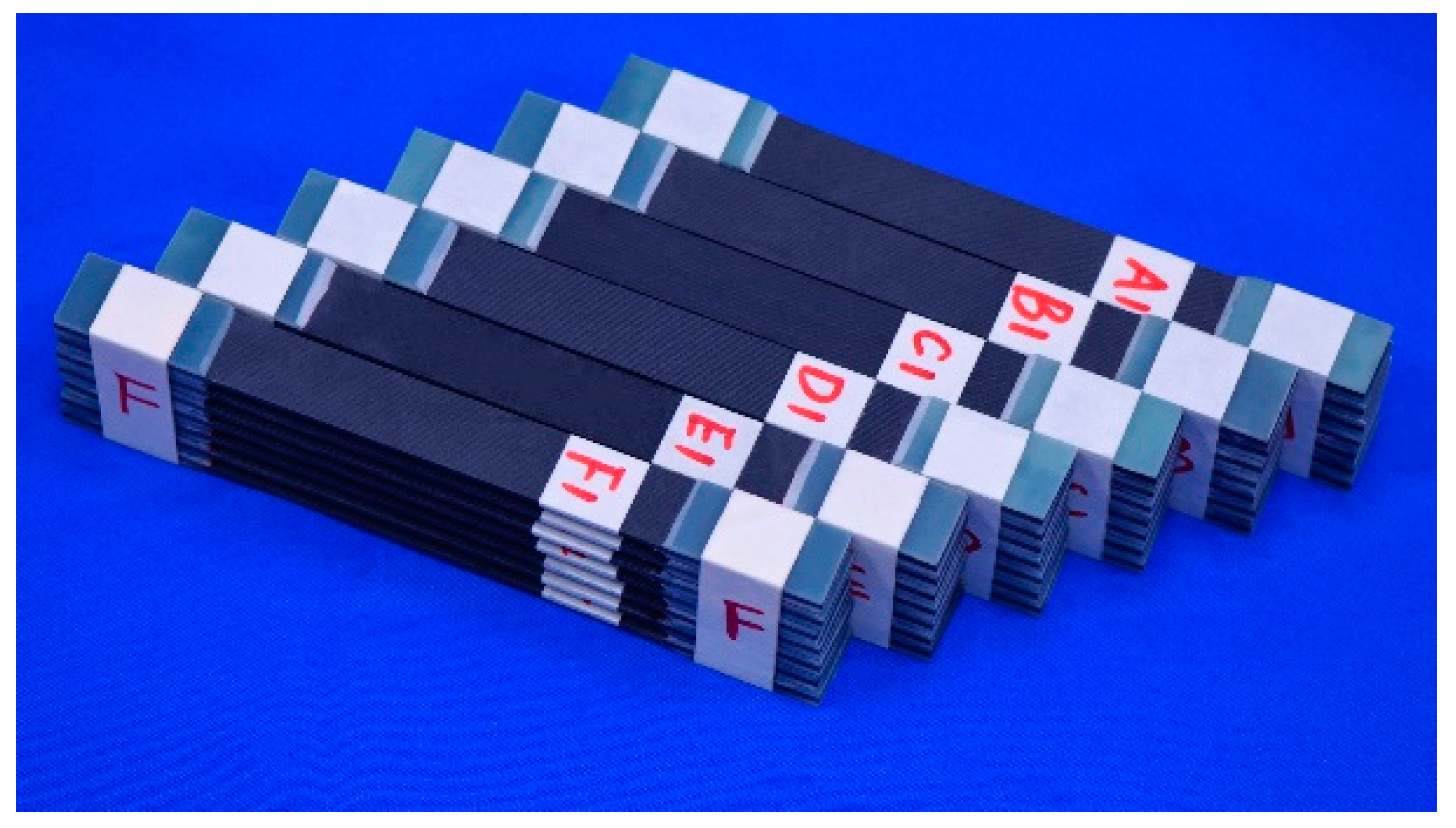
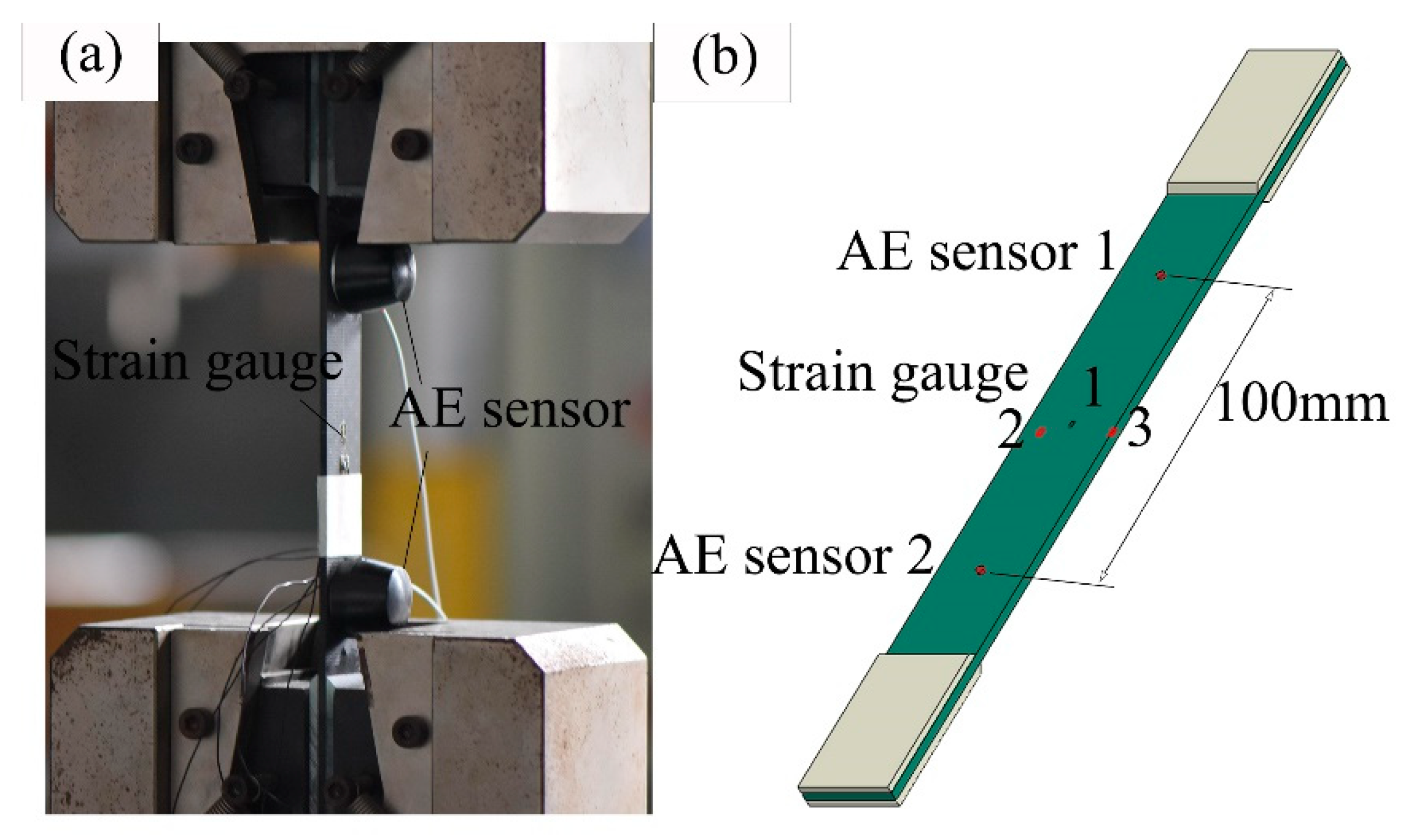

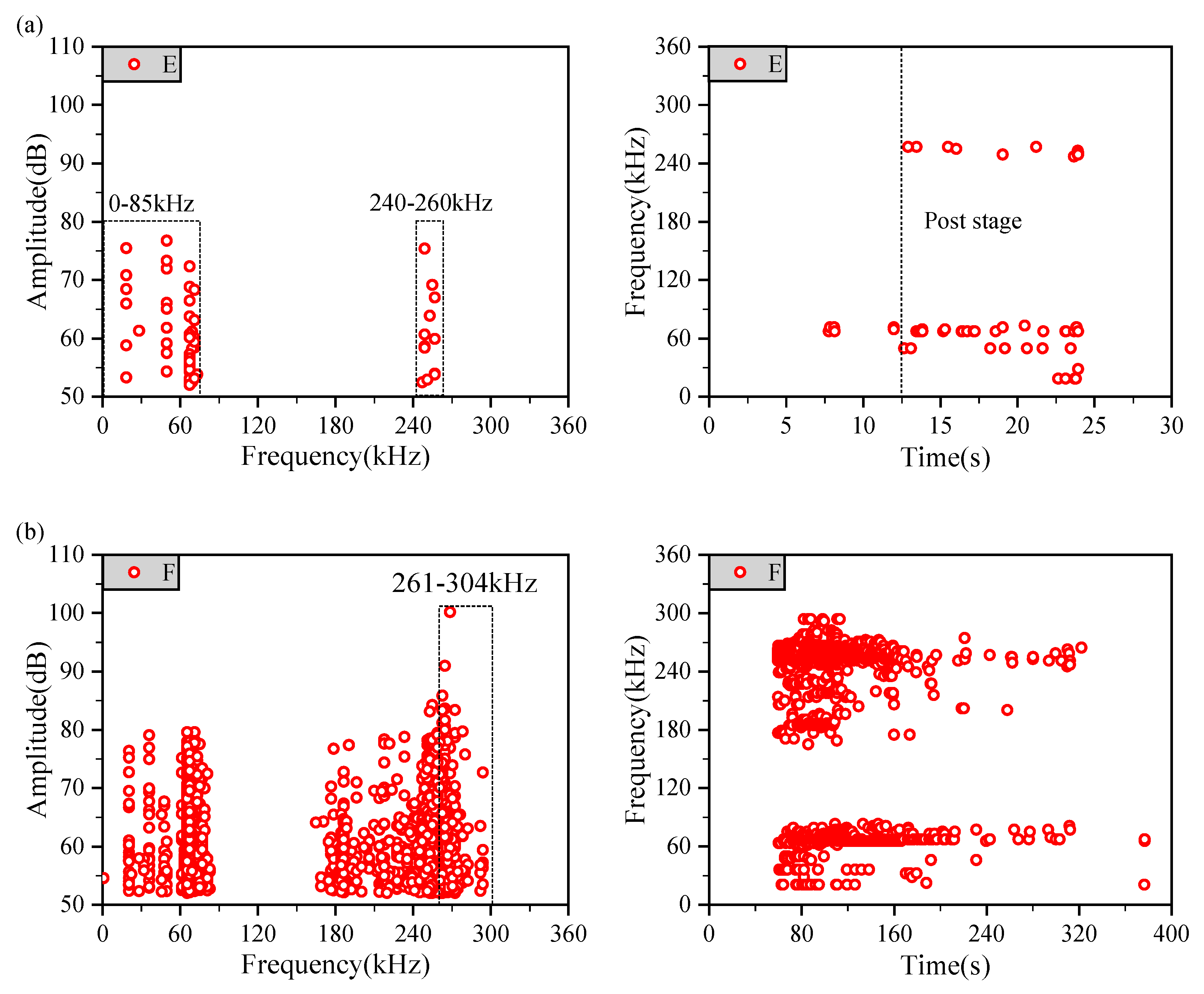
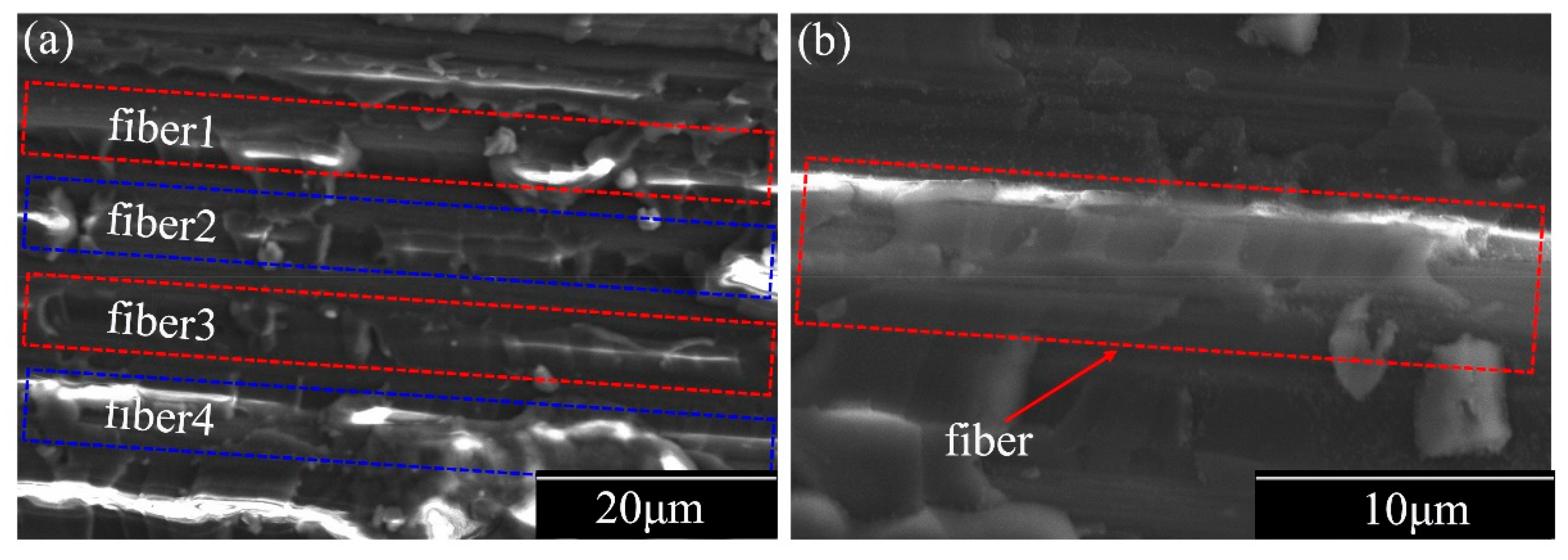


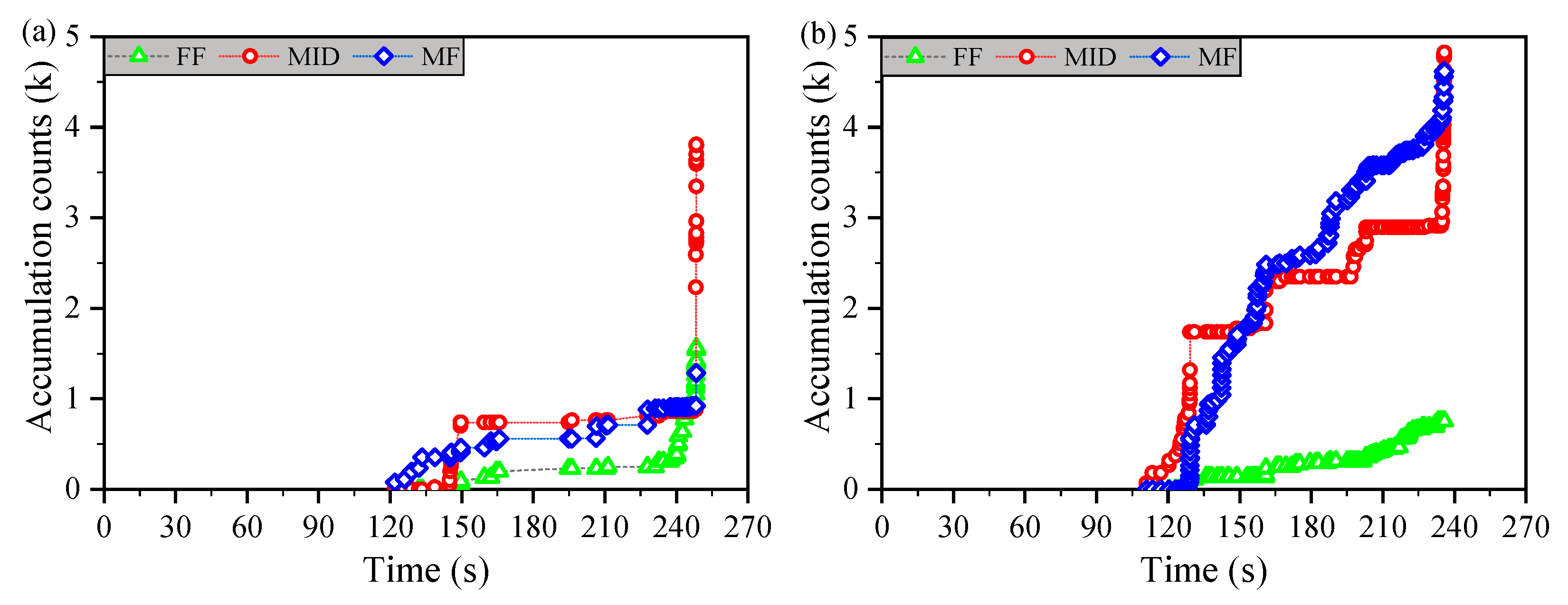

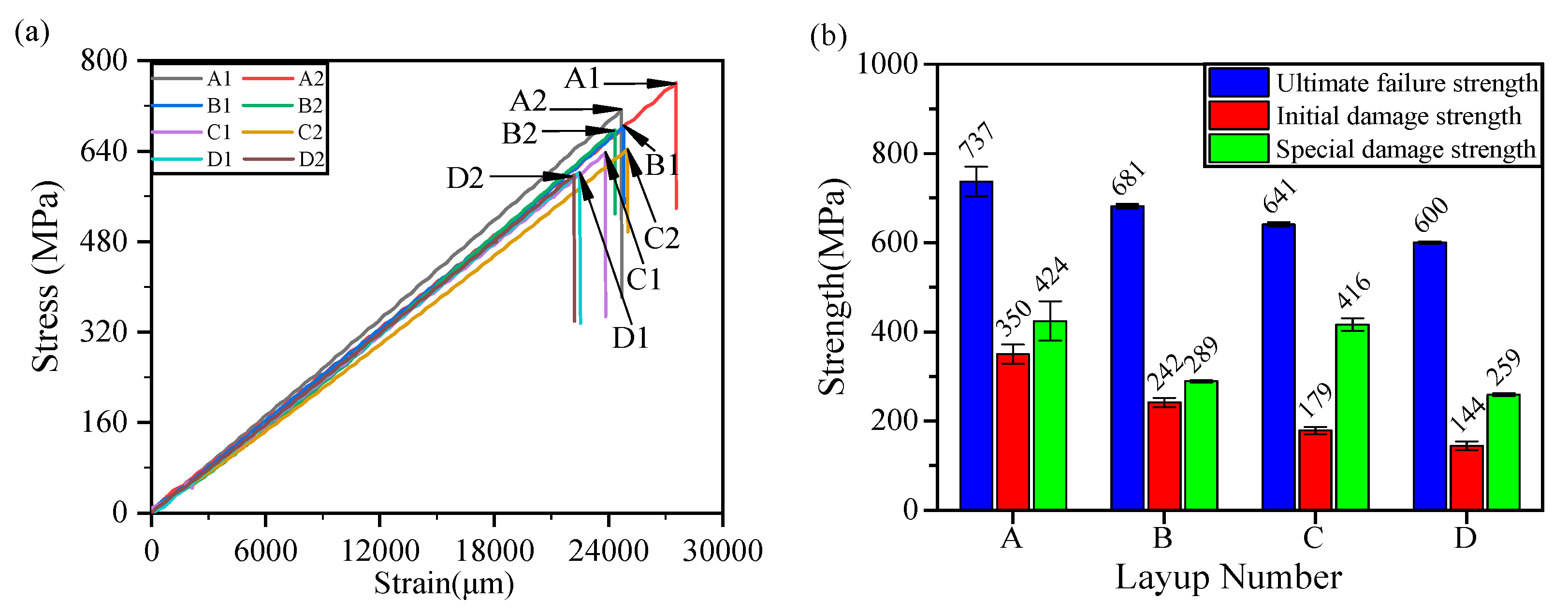
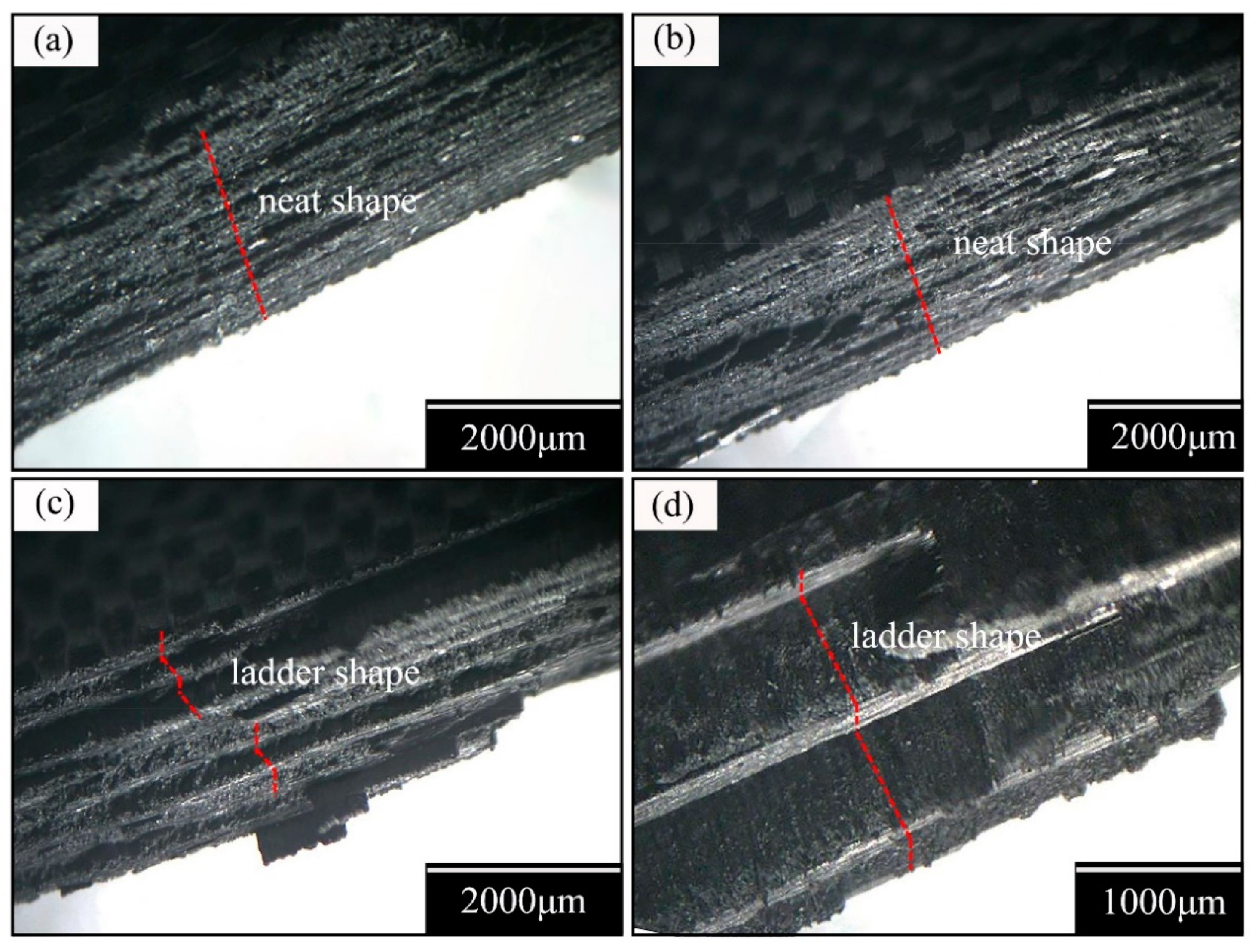

| Groups | Layups | Thickness (mm) | Length (mm) | Width (mm) |
|---|---|---|---|---|
| A | 02[[90/0]16s]02 | 2.6 | 250 | 25 |
| B | 02 [[902/02]8s]02 | 2.6 | 250 | 25 |
| C | 02 [[904/04]4s]02 | 2.6 | 250 | 25 |
| D | 02 [[908/08]2s]02 | 2.6 | 250 | 25 |
| E | [90] 68 | 2.6 | 250 | 25 |
| F | [0] 68 | 2.6 | 250 | 25 |
| Channel Threshold [25] | Acquisition Frequency | Center Frequency | Acquisition Point |
|---|---|---|---|
| 52 dB | 2 MHz | 255 kHz | 2048 |
| Damage Modes | MID | MF | FF |
|---|---|---|---|
| Frequency range/kHz | 0–85 | 240–260 | 261–304 |
Publisher’s Note: MDPI stays neutral with regard to jurisdictional claims in published maps and institutional affiliations. |
© 2021 by the authors. Licensee MDPI, Basel, Switzerland. This article is an open access article distributed under the terms and conditions of the Creative Commons Attribution (CC BY) license (http://creativecommons.org/licenses/by/4.0/).
Share and Cite
Zheng, K.; Cao, D.; Hu, H.; Ji, Y.; Li, S. Mechanical Properties of Thin-Ply Composites Based on Acoustic Emission Technology. Materials 2021, 14, 913. https://doi.org/10.3390/ma14040913
Zheng K, Cao D, Hu H, Ji Y, Li S. Mechanical Properties of Thin-Ply Composites Based on Acoustic Emission Technology. Materials. 2021; 14(4):913. https://doi.org/10.3390/ma14040913
Chicago/Turabian StyleZheng, Kaidong, Dongfeng Cao, Haixiao Hu, Yundong Ji, and Shuxin Li. 2021. "Mechanical Properties of Thin-Ply Composites Based on Acoustic Emission Technology" Materials 14, no. 4: 913. https://doi.org/10.3390/ma14040913






